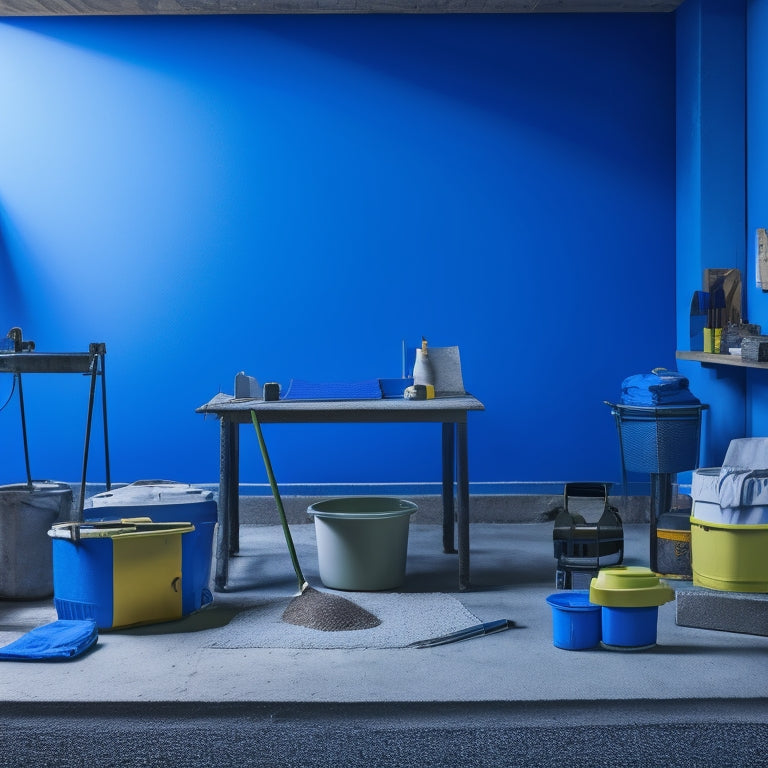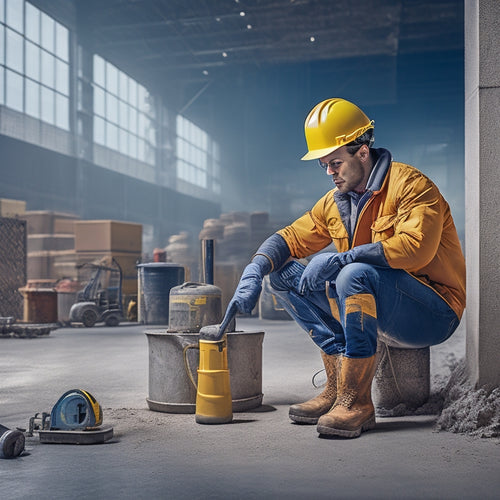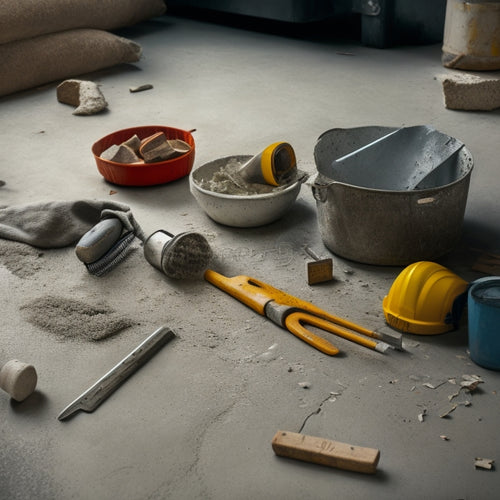
Essential Tools for Laying Concrete Blocks at Home
Share
You'll need a range of essential tools to lay concrete blocks at home, including a spirit level to guarantee perfect alignment, a tape measure for accurate placement, and a trowel to apply and smooth mortar. Specialized tools like a diamond blade saw or masonry saw are necessary for precise cutting, while safety equipment like hard hats, safety glasses, and dust masks protect you from hazards. Measuring and leveling tools, mixing and laying tools, and finishing tools for joints are also vital. With the right tools, you'll be well on your way to a successful project - and exploring these tools in more detail will help you master the skills.
Key Takeaways
• Essential tools for laying concrete blocks at home include a spirit level, tape measure, string line, trowel, and jointer/joint raker for accurate block placement.
• Specialized tools like diamond blade saws, masonry saws, and block chisels are necessary for precise block cutting and angle cutting.
• Safety equipment such as hard hats, safety glasses, steel-toed boots, and dust masks are crucial for protecting oneself from hazards during block handling.
• Gloves and hand protection tools like heavy-duty protective gloves with padding and extra grip can prevent hand fatigue and injuries.
• Measuring and leveling tools like laser levels, block alignment tools, and measuring tapes ensure accurate block placement and spacing for a strong structure.
Essential Hand Tools for Block Laying
You'll need six essential hand tools to guarantee accurate and efficient block laying, including a spirit level, tape measure, string line, trowel, jointer, and hammer.
With these tools, you'll be able to master block laying techniques and avoid common block mistakes that can compromise the integrity of your structure.
A spirit level certifies your blocks are perfectly aligned, while a tape measure helps you achieve precise measurements.
A string line guides your block laying, keeping your course straight and level. Your trowel will be your go-to tool for applying and smoothing mortar, and a jointer will help you finish joints with precision.
Finally, a hammer will come in handy for tapping blocks into place.
By having these essential hand tools at your disposal, you'll be able to execute your block laying project with confidence and precision.
With practice and patience, you'll develop the skills to lay blocks like a pro, and your finished project will be a reflection of your hard work and attention to detail.
Specialized Tools for Block Cutting
When you're working with concrete blocks, you'll often need to make precise cuts to fit them together seamlessly.
You'll want to master various block cutting methods to achieve professional-looking results.
To get started, you'll need to choose the right specialized tools for precise angle cutting and clean edge creation.
Block Cutting Methods
Cutting concrete blocks to fit around obstructions or to achieve a specific design requires specialized tools that guarantee accurate, clean cuts and minimize waste.
When it comes to block cutting methods, you'll want to master various techniques to guarantee precision and efficiency. Here are some essential tools and techniques to add to your arsenal:
-
Diamond blade saw: Ideal for making straight cuts, this saw is equipped with a diamond-coated blade that can handle even the toughest concrete blocks.
-
Masonry saw: A more economical option, masonry saws use abrasive blades to make cuts, but may not be as precise as diamond blade saws.
-
Block chisels: For more intricate cuts or when you need to remove small portions of the block, block chisels are a great option.
- Wet cutting tools: These tools reduce dust and debris, making them ideal for indoor projects or when working in confined spaces.
Remember to always follow proper cutting tool maintenance to guarantee your tools remain in top condition.
Regularly cleaning and sharpening your blades will help you achieve professional-looking results. By mastering these block cutting techniques, you'll be able to tackle even the most complex projects with confidence.
Precise Angle Cutting
Achieving precise angle cuts in concrete blocks requires specialized tools that can handle the demands of intricate masonry work, particularly in projects that involve curved or angled walls, corners, or decorative features.
You'll need a miter saw or a circular saw with a specialized concrete blade to make precise angle cuts. These saws allow you to set exact angles using angle measurement techniques, ensuring accurate cuts every time.
When cutting angles, it's crucial to follow cutting accuracy tips. First, always use a straightedge or guide to prevent the saw from deviating from the desired angle.
Second, make slow and steady cuts, applying gentle to moderate pressure. This will help prevent the blade from binding or kicking back.
Third, use a diamond-coated blade, which is specifically designed for cutting concrete and will provide a cleaner, more accurate cut.
Clean Edge Creation
To guarantee a professional finish, you'll need to equip yourself with specialized tools that can help you create clean, precise edges when cutting concrete blocks.
Edge finishing is a critical step in laying concrete blocks, and it requires the right tools to get the job done. When it comes to surface preparation, having the right tools can make all the difference.
Here are some essential tools you'll need for clean edge creation:
-
Block chisels: These are used to remove excess concrete and create a clean edge.
-
Concrete saws: These are powerful tools that can cut through concrete blocks with ease, leaving a clean, precise edge.
-
Edge grinders: These are used to smooth out rough edges and create a uniform finish.
- Diamond blades: These are high-performance blades that can cut through concrete blocks quickly and efficiently, leaving a clean, precise edge.
Safety Equipment for Block Handling
As you prepare to handle concrete blocks, you'll need to prioritize your safety above all else.
You'll want to make certain you're equipped with the right protective gear to prevent injuries, which can be devastating and even career-ending.
In this section, you'll learn about the essential safety equipment you'll need, including protective gear, gloves, and eye and face shields, to safeguard yourself against the risks associated with block handling.
Protective Gear Essentials
You'll need to wear essential protective gear to prevent injuries and assure a safe working environment when handling concrete blocks. As you lay concrete blocks, you'll be exposed to heavy lifting, sharp edges, and potential falling hazards. To meet safety standards, you must prioritize protective gear to guarantee your well-being.
Here are the essential protective gear items you shouldn't skip:
-
Hard hat or safety helmet: Protect your head from falling blocks, debris, or tools.
-
Safety glasses or goggles: Shield your eyes from dust, debris, and chemical splashes.
-
Steel-toed boots: Prevent foot injuries from heavy blocks, tools, or equipment.
- Dust mask or respirator: Breathe safely when working with concrete dust or other airborne particles.
Gloves and Hand Protection
What's the best way to safeguard your hands from abrasions, cuts, and crush injuries when handling concrete blocks?
Invest in high-quality, heavy-duty protective gloves specifically designed for block laying. These gloves will provide the necessary barrier between your skin and the rough, heavy blocks.
Look for gloves with reinforced palms, fingers, and thumbs to prevent abrasions and cuts. Additionally, opt for gloves with padding on the fingers and wrists to reduce hand fatigue, allowing you to work longer without discomfort.
You'll appreciate the extra grip and dexterity these gloves offer, making it easier to handle and place blocks with precision.
Don't compromise on your hand protection – it's crucial to prevent injuries that can derail your project. Choose gloves that meet or exceed industry standards for impact resistance, abrasion resistance, and puncture resistance.
Eye and Face Shields
Protecting your eyes and face from flying debris, dust, and mortar splashes is just as essential as safeguarding your hands when handling concrete blocks. You can't afford to take any chances when it comes to your vision and facial safety.
To guarantee the best eye protection and face safety, make sure you have the following essential tools in your arsenal:
-
Safety glasses or goggles: These should have shatter-resistant lenses and a snug, comfortable fit to prevent dust and debris from entering.
-
Face shields: These provide additional protection for your face and can be worn over safety glasses for extra protection.
-
Dust masks or respirators: These help filter out dust and other airborne particles that can irritate your eyes and face.
- Full-face respirators: These provide the highest level of protection, covering your entire face and eyes from dust, debris, and other hazards.
Measuring and Leveling Tools Required
Accurate measurements and leveling are vital in laying concrete blocks, and a variety of tools are necessary to achieve this precision.
You'll need a reliable tape measure to guarantee accurate block placement and spacing. This tool will help you measure the length, width, and height of your blocks, as well as the distance between them. When choosing a tape measure, opt for one that's durable, accurate, and easy to read.
In addition to a tape measure, a laser level is important for confirming your blocks are perfectly level. This tool projects a level line or dot onto your work surface, allowing you to accurately position your blocks. Look for a laser level that's self-leveling and has a long battery life. You may also consider a model with a built-in inclinometer, which measures the angle of your blocks.
Mixing and Laying Block Tools
With your blocks accurately measured and leveled, you can now focus on preparing the mortar and laying the blocks, which requires a set of specialized tools. Mortar mixing is a critical step in the process, and having the right tools will guarantee a strong and durable bond between the blocks.
You'll need the following essential tools for mixing and laying blocks:
-
A mortar mixing tub or wheelbarrow to mix and hold the mortar
-
A pointing trowel for scooping and applying mortar to the blocks
-
A spirit level to guarantee block alignment and prevent deviations
- A block alignment tool or straightedge to maintain a straight line and check block alignment
Using these tools, you'll be able to mix and lay your blocks with precision and accuracy, guaranteeing a strong and durable structure.
Remember to follow the manufacturer's instructions for mixing and applying the mortar, and take your time to guarantee each block is properly aligned before moving on to the next one.
Finishing Tools for Block Joints
You'll need to seal the block joints properly to guarantee the structure's integrity, and that's where finishing tools come into play. To achieve professional-looking joints, you'll require a set of specialized tools.
Start with a jointer or joint raker, which helps remove excess mortar and creates a uniform joint width. Next, use a pointing trowel to fill the joints with fresh mortar, ensuring a smooth, even finish.
For a more refined look, incorporate joint finishing techniques such as 'buttering' and 'striking' to create a concave or V-shaped joint profile. This not only enhances mortar joint aesthetics but also improves the joint's strength and durability.
Don't forget a joint brush or finishing tool to remove excess mortar and create a clean, defined edge. Finally, use a grout sponge or float to remove excess grout and achieve a smooth, even finish.
Frequently Asked Questions
Can I Use a Regular Hammer for Laying Concrete Blocks?
When it comes to block laying, you'll want to choose the right hammer for the job.
While you might be tempted to use a regular hammer, it's not the best option.
You'll need a hammer specifically designed for block laying, like a block hammer or a masonry hammer, which provides more force and control.
These hammers are built to handle the weight and density of concrete blocks, ensuring a solid bond and a professional finish.
How Do I Prevent Mortar From Staining My Tools?
Don't let mortar turn your prized tools into rusty relics!
To prevent staining, you'll want to prioritize mortar cleanup and tool maintenance. As you work, regularly wipe your tools with a damp cloth to remove excess mortar.
After the job, soak your tools in water and scrub them with a wire brush to remove dried mortar.
Dry and oil your tools to prevent rust, and you'll be ready to tackle the next project with precision and power.
Can I Lay Concrete Blocks in the Rain or Snow?
You're wondering if you can lay concrete blocks in the rain or snow. The answer is, it's not recommended.
Inclement weather conditions can compromise block stability, leading to structural issues down the line. Water can seep into the mortar, causing it to weaken, and freezing temperatures can make the blocks more prone to cracking.
For a solid, long-lasting structure, it's best to wait for dry, calm weather.
Do I Need to Cure the Concrete Blocks After Laying?
As you build your fortress, don't forget to tend to its foundation. You've laid the concrete blocks, but now it's time to nurture their strength.
Curing is essential to achieving maximum block strength. You'll need to choose the right curing methods, whether it's applying a membrane, using curing compounds, or keeping the blocks moist.
Don't skip this step, or your structure will crumble. You've worked hard to build; now, seal the deal with proper curing.
Can I Use a Mixture of Cement and Sand as Mortar?
When mixing your own mortar, you'll want to get the composition just right.
While it's tempting to use a mixture of cement and sand, you're better off with a more nuanced approach.
Aim for a sand ratio of 1 part cement to 2-3 parts sand. This balance guarantees the right consistency and strength for your blocks.
Don't skimp on the ratio, or you'll risk compromised structural integrity.
Get it right, and your DIY project will be rock-solid.
Conclusion
As you complete your concrete block laying project, remember that having the right tools is vital to achieving professional results.
With the essential hand tools, specialized cutting equipment, safety gear, measuring and leveling devices, mixing and laying tools, and finishing tools, you'll be well-equipped to tackle any project.
Did you know that the global concrete block market is projected to reach $2.6 billion by 2025?
With the right tools and skills, you can tap into this growing market and create stunning structures that stand the test of time.
Related Posts
-

10 Best Tools for Sealed Concrete Flooring on Budget
When starting on a sealed concrete flooring project on a budget, you'll need to prioritize essential tools without sa...
-

Top 10 Concrete Repair Tools for Small Fixes
You'll need the right tools to tackle small concrete repairs efficiently and effectively. When it comes to small fixe...
-

Why These Tools Are Crucial for Concrete Patio
You're about to commence on a concrete patio project, and having the right tools is vital to achieving professional-l...


